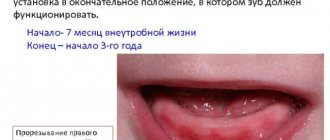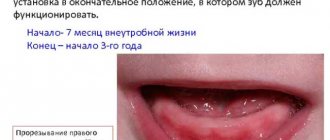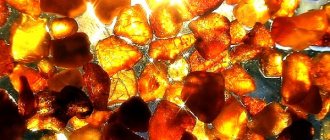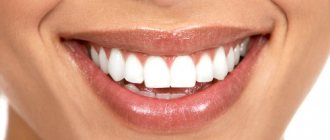What reaction is possible for a baby when teething?
What reaction can a child have when baby teeth appear? During this period, children may react in different ways:
- Some children tolerate this period quite normally. The only symptom that worries them is itching in the gums, increased salivation and a slight increase in body temperature.
- Other babies react very hard to teething: the temperature may rise to 38-39 degrees, they do not sleep at night, and refuse to eat.
- There are also little ones who are luckier than others: their teeth appear without any problems and almost imperceptibly.
Permanent teeth
The change in the primary bite begins in children aged 5-6 years. By this time, the roots of baby teeth begin to dissolve and tooth mobility appears.
- At this age (5-6 years), the lower front incisors are the first to be replaced. In parallel with them, at about 6 years of age, the first permanent chewing teeth appear. Often their appearance is not even noticed, since they erupt behind the milk teeth.
- At 6-7 years old, the upper front incisors are replaced
- At 7-9 years of age, the baby teeth will fall out and be replaced by permanent lateral incisors.
- At the age of 9-11 years , the fourth and fifth milk teeth (molars) will be replaced by the 1st and 2nd premolars.
- The last ones, at the age of 11-13 years, will be replaced by permanent teeth - fangs.
- By the age of 12-13, all baby teeth will be replaced by permanent ones and the child’s mouth now has 24 teeth. Oral hygiene often suffers at this age. This is due to adolescence. Carise especially often affects the fissures (grooves) of the sixth teeth - molars. The process happens very quickly and often develops into pulpitis! Therefore, it is important to pay attention to caries prevention. A good way to protect the fragile enamel of permanent teeth is by sealing fissures and maintaining some professional hygiene. and, of course, following some rules.
- At 13-14 years of age, the second molars (seventh teeth) will erupt.
- And already at the age of 18, and sometimes later, wisdom teeth appear.
In order to keep your teeth healthy and straight, we recommend that you come for a preventive examination to the dentist every 6 months and visit the orthodontist at the ages of 6, 12 and 18 years.
What causes the temperature to rise during teething in children?
When babies erupt their first teeth, 2 processes occur that are interconnected:
- In the oral cavity, local immunity decreases, which is why a secondary infection may occur. Stomatitis, sore throat, pharyngitis and other diseases can often occur.
- At the site of tooth growth, the production and release of many biologically active substances necessary for softening the gums occurs.
- Inflammation of the gums and reduced immunity often provoke a protective reaction of the body - body temperature rises to 37-37.5.
In infants, when teething, the body temperature should not be higher than 37.5 degrees (the so-called low-grade fever).
During this period, it is necessary to carefully monitor the general condition of the baby. There are children who tolerate this temperature quite normally. And for others, help is needed in order to survive such an unpleasant period. Sometimes children may be bothered by a slight increase in it, they may cry, be capricious, refuse to eat, or not sleep at night.
Important: keep in mind that if a baby experiences an increase in body temperature to 38-38.5 °C, consult a doctor immediately. In no case should you attribute everything to your teeth, as such a symptom may indicate an additional infection or inflammatory process.
How long during teething do children usually have a fever? Normally this is no more than 1-3 days. Most often it rises at night, does not exceed 38 degrees and is easily knocked down.
Important: if your little one has a fever for more than three days, the temperature is above 38 degrees and does not go down well, seek medical help immediately.
“Why do other children already walk at 9 months, but mine is not yet?”
The development skills mentioned are indicative only. If a baby at nine months does not speak, crawls little or only crawls on its belly and does not try to get up, there is no need to worry. Every child is different and while we can help them develop, they learn new skills at their own pace and in their own time. In addition, already at 9 months of age, the difference in development between boys and girls becomes noticeable.
But if there is something that worries you, even the smallest thing, share your concerns with your baby’s pediatrician. Only the doctor will determine what is the norm for proper development for your baby, and what you need to pay attention to. Whether it is necessary to take a massage course to prepare for walking, sign up for a swimming pool to support immunity and sound sleep, introduce new educational games and work on hearing and speech, or on the fact that the child does not sit independently - the answers to these questions are individual and depend on many factors. A child never needs everything at once: listen to the recommendations of specialists.
*The ideal food for an infant is mother's milk. WHO recommends exclusive breastfeeding for the first 6 months. MAMAKO® supports this recommendation. Before introducing new foods into your baby’s diet, consult a specialist.
Why is high temperature dangerous for a child and when should you sound the alarm?
High temperature (39-40 degrees) is extremely dangerous for children in their first year of life. Because of this, disruption of the central nervous system and heart, and convulsions are possible. A rapid increase over several hours and one that is difficult to bring down with antipyretics is very dangerous.
As a result of a sharp increase, the temperature center of the brain is not able to withstand such a load, which can cause seizures. Children with central nervous system pathology are at risk. They cannot be risked, and the temperature must be brought down as soon as it has already risen to 37.5 degrees.
What to do if your child has a fever?
If, when teething, the child is restless, asks to be held, or cries, there is no need to worry. All parents go through this, you are not the first and you will not be the last. It is much worse if the baby does not react to anything, constantly sleeps and behaves very calmly. When the temperature rises, this is an alarming signal.
In this case, monitor your child with special attention and measure the temperature every hour. This can be done in the crease near the groin or armpit. To do this, it is better to use an electronic thermometer: it will be able to show you the result much faster than a mercury thermometer, in addition, it is more accurate. It is also safer and cannot be broken.
If the child’s temperature cannot be measured this way, it can be done rectally. To do this, lubricate the tip of the thermometer with baby cream, then carefully insert it into the rectum. Pinch the child's buttocks and wait for a signal indicating that the measurement is complete.
Important: when measured in the rectum, the values will always be higher compared to those in the armpit. The norm is a temperature within 37-37.5 degrees. Once you get a score of 38.5 or higher, be sure to shoot it down.
How do you know if your baby is unwell? There are signs that indicate a condition where high fever is dangerous:
- The skin feels dry and hot to the touch.
- Lips become dry.
- Eyes sparkle.
- Cheeks turn red.
- The baby rarely urinates.
If you see them, remember that urgent help is needed, because this condition is extremely dangerous for the child’s body.
What complementary foods does a 9 month old baby eat?
The diet of a 9-month-old baby is already quite varied. Your baby can continue to receive breast milk and/or formula and complementary foods. The products will no longer include only cereals, vegetables, meat and dairy products, but also bread, butter and vegetable oil, and fish. And in order not to harm the baby, when switching to a “common table”, mothers adhere to the scheme for introducing complementary foods
— the table contains recommended foods for feeding and portion sizes per day depending on the child’s age. Complementary feeding introduced in a timely manner will become the basis for proper nutrition and good appetite even for small children.
What else should you pay attention to?
If you are no longer breastfeeding or your baby has been bottle-fed since birth, we advise you not to rush into introducing whole cow's milk and the milk of other animals. Let only baby formula remain in the diet for now, since it is adapted to the physiological characteristics of the digestion of babies, which means it is easier to digest.
Among MAMAKO® baby food there are mixtures for children in the second half of life, and complementary feeding products for a baby at nine months (including for nutrition with a tendency to allergies). Buckwheat and corn porridge, 5-grain porridge and cream soups of pumpkin and spinach with goat's milk, fruit puree with goat's curd - all these are complementary feeding options allowed by pediatricians for children under one year old.
From 6 months to 2 years, young children are especially open to new taste sensations. And mother can help her baby develop them. How? Try offering your child multi-ingredient cereals. For example, buckwheat porridge with apple and carrots. Many kids are very curious about new and varied tastes and eat such treats with pleasure.
Teeth in children: order of eruption of baby teeth
The eruption of baby teeth in children is a strictly individual process for each child. Normally, there are deviations of 5-6 months from the stated standards. Most babies begin to cut their first teeth at 6 months, but there are cases where this process begins already in the first three months or only after a year. Moreover, it is not at all necessary that the rudiments be visible at the initial stage. Children's teeth can start cutting in at six months, and the first white bumps will be noticeable by one year.
Standard timing of baby teeth eruption
As a rule, this process begins faster in girls than in boys. In babies with rapid development, the first teeth can be seen at 3-4 months, but it is normal for the process to begin before the age of twelve months. If the timing of the eruption of baby teeth does not correspond to the norm, this is a reason to consult a dentist.
A delay in the natural process may be due to the following factors:
- lack of calcium in the body;
- problems with physical development;
- lack of thyroid hormones;
- metabolic problems;
- edentia – complete absence of the rudiments of baby teeth;
- rickets;
- hereditary predisposition.
Attention! The fact that a child of 1 year is missing primary teeth is not a pathology. Perhaps this is an individual feature. Sometimes parents simply cannot determine the presence of rudiments (the child closes his mouth and does not allow adults to examine the oral cavity). Then a consultation with a pediatric dentist is required, who will conduct a physical examination, assess the condition and give recommendations.
The order of eruption of baby teeth
The standard teething scheme for babies is as follows:
- the incisors in the center come first;
- lateral incisors emerge;
- next – the first molars;
- then fangs;
- The second molars emerge last.
As practice shows, in many children the teeth from below begin to grow first, but there are often cases when the first incisors and molars have already emerged from above, but not yet from below. If an examination by a pediatric dentist and pediatrician shows normal results, you just need to wait a little.
The misconception is that the more calcium in a child’s diet, the faster his teeth will erupt. Many parents begin to introduce cottage cheese, milk porridge, and hard cheese into complementary foods too early, supposedly to speed up this process. In no case should you follow this example to avoid excess calcium in the body and other health problems. Nutrition should be complete, varied, healthy. The time will come, and the teeth will erupt naturally.
By the age of two and a half, the child should have all his teeth: on each half of the jaw there should be two molars, one canine and two incisors. Baby teeth come out symmetrically to each other, there should be 20 units in total, that is, 10 on top and bottom.
Formula for calculating the number of teeth for children under 2 years of age
There is also a formula that can be used to count baby teeth. The order of teething is as follows: the child’s age in months minus six months - the number of teeth is obtained. For example, if a child is 15 months old, then we subtract 6 from 15 and get 9. Accordingly, the baby normally has 9 teeth that have erupted at the moment.
What if the baby was born with teeth already erupting?
It also happens that children are born with already erupted teeth, or they come out in the first few weeks of life. In such cases, it is necessary to seek help from a pediatrician and dentist. Sometimes the presence of incisors and molars interferes with natural breastfeeding, and the child is transferred to artificial feeding, or is fed with a bottle of breast milk and a pacifier.
How can you tell when your child’s teeth have started cutting?
Symptoms of the emergence of the first incisors and other dental units are as follows:
- the baby becomes restless;
- there is excessive salivation;
- the child actively begins to put toys and foreign objects into his mouth;
- baby sucks fingers;
- often asks for a breast or pacifier;
- day and night sleep is disrupted;
- the child becomes whiny and irritable;
- there is a refusal to eat;
- temperature rises;
- The gums are slightly swollen.
Attention! The fact that you do not see the first rudiments of a tooth (a white dot on the gum) does not mean that it is not erupting. On the contrary, the process of coming out is the most painful, and when the tooth appears on the surface, the baby’s condition returns to normal.
Pediatric dentists at the Zuub.rf clinic are ready to provide advice and medical assistance to children during teething. If your child is worried about his teeth, or you have suspicions about the order in which his baby teeth come out, a medical examination with a doctor will definitely help! The dentist will examine the condition of the child’s teeth, give detailed recommendations and rule out pathologies often “contrived” by parents.
If you have the symptoms described in this article, be sure to make an appointment at our clinic.
Don't self-medicate! Even the smallest problem, if not treated correctly, can significantly complicate your life.
By contacting us, you can be sure that:
- Get high-quality and free consultation .
- You will receive the best prices for treatment and the opportunity to receive a special promotional price.
- Only modern equipment and materials will be used.
- You will be treated by professional doctors with many years of experience.
- We offer treatment on credit or in installments. There is also the possibility of obtaining a tax deduction.
- We work seven days a week and without a lunch break, from 9 a.m. to 10 p.m.
+7









